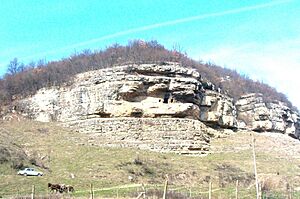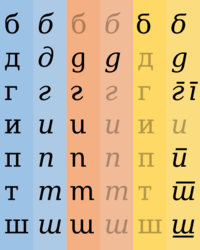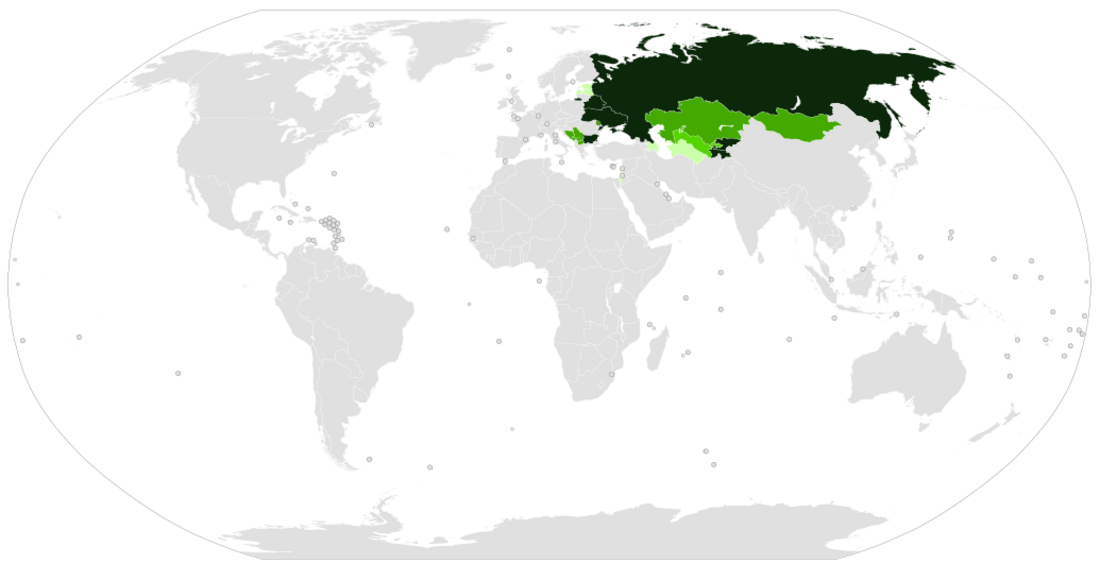Cyrillic script facts for kids
Quick facts for kids Cyrillic script |
|
|---|---|

1850s Romanian text (Lord's Prayer), written with the Cyrillic script
|
|
| Type | Alphabet |
| Spoken languages | See Languages using Cyrillic |
| Time period | Earliest variants exist c. 893 – c. 940 |
| Parent systems |
Egyptian hieroglyphs
|
| Child systems | Old Permic script |
| Sister systems | |
| Unicode range |
|
| ISO 15924 | Cyrl |
|
Names: Belarusian: кірыліца; Bulgarian: кирилица [ˈkirilit͡sɐ]; Macedonian: кирилица [kiˈrilit͡sɐ]; Russian: кириллица [kʲɪˈrʲilʲɪtsə]; Serbian: ћирилица [t͡ɕirǐlit͡sa]; Ukrainian: кирилиця [kɪˈrɪlɪt͡sʲɐ].
|
|
| Note: This page may contain IPA phonetic symbols in Unicode. | |
The Cyrillic script (pronounced sih-RI-lik) is a special writing system used for many languages across Europe and Asia. It is the main alphabet in several countries. These include places where people speak Slavic languages, Turkic languages, Mongolic languages, and others. You can find it used in Eastern Europe, Central Asia, and even parts of East Asia.
As of 2025, about 250 million people in Europe and Asia use Cyrillic as their official alphabet. Russia alone accounts for about half of these users. When Bulgaria joined the European Union in 2007, Cyrillic became the third official alphabet of the EU. The other two are the Latin script and the Greek alphabet.
The Early Cyrillic alphabet was created in the 9th century AD. This happened in the First Bulgarian Empire during the time of Tsar Simeon I the Great. It was likely developed by students of Saints Cyril and Methodius. These two Byzantine brothers had earlier created the Glagolitic script. The Cyrillic script is named to honor Saint Cyril.
Contents
Why is it Called Cyrillic?
The Cyrillic script was developed and made popular by the students of Cyril and Methodius in Bulgaria. It was not created by Cyril and Methodius themselves. So, its name is a way to show respect to Saint Cyril, rather than saying he was the one who wrote it.
History of the Cyrillic Script
The Cyrillic script was first created in the First Bulgarian Empire. Many experts believe the Early Cyrillic alphabet was made at the Preslav Literary School. This school was a very important center for learning and culture in the First Bulgarian Empire. It was also important for all Slavs.
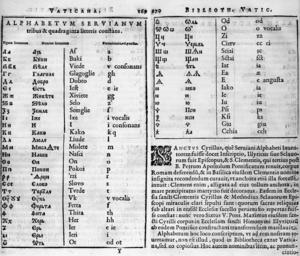
Scholars at Preslav used the Greek uncial script as a base. They added new letters from the older Glagolitic alphabet. These new letters were for sounds not found in Greek. Important Bulgarian writers and scholars worked at this school. They included Naum of Preslav, Constantine of Preslav, and Joan Ekzarh.

The Cyrillic script then spread to other Slavic people. It was also adopted by non-Slavic people like the Romanians. The oldest known Cyrillic writings were found in the area of Preslav in Bulgaria. The new script became the foundation for alphabets used in many languages in Eastern Europe. This included both Slavic and non-Slavic languages, like Romanian until the 1860s. For many centuries, Catholic and Muslim Slavs also used Cyrillic.
Cyrillic and Glagolitic were used for the Church Slavonic language. Cyrillic became more common than Glagolitic by the 12th century. The writings created in Old Church Slavonic spread from Bulgaria to the north. It became the common language for communication in the Balkans and Eastern Europe.
In modern-day Bosnia, a type of Cyrillic alphabet was used in the Middle Ages. The earliest signs of this script appeared between the 10th or 11th centuries. The Humac tablet is believed to be the first document using this script. It was used until the 18th century, and sometimes even into the 20th century.
In the early 1700s, Peter the Great, the Tsar of Russia, made big changes to the Cyrillic script used in Russia. He wanted the letters to look more like those in the Latin alphabet. This new style was called the Civil script. Some old letters were removed, and new ones were added. Letters also started to have both uppercase and lowercase forms.
Over time, Cyrillic changed to fit different languages. It also developed different styles in different regions. A famous change was made by Vuk Stefanović Karadžić. He updated the Serbian Cyrillic alphabet. He removed letters that were no longer used in spoken Serbian. He also added new letters specific to Serbian. Today, many languages in the Balkans, Eastern Europe, and northern Eurasia use Cyrillic alphabets.
Cyrillic Letters and Numbers
The Cyrillic script spread across East Slavic and some South Slavic areas. It was adapted to write local languages, such as Old East Slavic. This led to many different Cyrillic alphabets.
Early Cyrillic Alphabet
The early Cyrillic alphabet had many letters. Some of these letters are still used today, while others have changed or are no longer in use.
| А | Б | В | Г | Д | Є | Ж | Ꙃ | Ꙁ | И | Ї | Ꙉ | К | Л | М | Н | О | П | Ҁ | Р | С | Т | ОУ |
| Ф | Х | Ѡ | Ѿ | Ц | Ч | Ш | Щ | Ъ | ЪI | Ь | Ѣ | Ꙗ | Ѥ | Ю | Ѫ | Ѭ | Ѧ | Ѩ | Ѯ | Ѱ | Ѳ | Ѵ |
Capital and Small Letters
In old manuscripts, there was no difference between capital (uppercase) and small (lowercase) letters. This changed over time.
Numbers in Cyrillic
The letters in early Cyrillic also had number values. These values were based on their Greek ancestors, not on their alphabetical order.
| 1 | 2 | 3 | 4 | 5 | 6 | 7 | 8 | 9 |
| А | В | Г | Д | Є (Е) | Ѕ (Ꙃ, Ꙅ) | З (Ꙁ) | И | Ѳ |
| 10 | 20 | 30 | 40 | 50 | 60 | 70 | 80 | 90 |
| І (Ї) | К | Л | М | Н | Ѯ (Ч) | Ѻ (О) | П | Ч (Ҁ) |
| 100 | 200 | 300 | 400 | 500 | 600 | 700 | 800 | 900 |
| Р | С | Т | Ѵ (Ѵ, Оу, Ꙋ) | Ф | Х | Ѱ | Ѡ (Ѿ, Ꙍ) | Ц (Ѧ) |
Currency Signs from Cyrillic
Some money symbols come from Cyrillic letters:
- The Ukrainian hryvnia sign (₴) comes from the cursive Ukrainian Cyrillic letter He (г).
- The Russian ruble sign (₽) comes from the capital letter Р.
- The Kyrgyzstani som sign (⃀) comes from the capital letter С (es).
- The Kazakhstani tenge sign (₸) comes from Т.
- The Mongolian tögrög sign (₮) comes from Т.
How Cyrillic Letters Look
Cyrillic letters changed from their medieval look to a more modern style. This happened without a "Renaissance" period like in Western Europe. Old Cyrillic letters were often tall and narrow.
Peter the Great, the Tsar of Russia, made changes in the early 1700s. He wanted Cyrillic letters to look more like Western European letters. These new forms were called the Civil script. Over time, other languages using Cyrillic adopted these new styles. Today, modern Cyrillic letters look very similar to modern Latin letters in the same font family.
Lowercase Letter Shapes
Cyrillic capital and lowercase letters are not as different as in Latin writing. Many lowercase Cyrillic letters are like small capital letters. However, some have adopted shapes similar to Latin lowercase letters.
Cyrillic fonts also have upright (roman) and slanted (italic) forms. In many Slavic languages, the words "roman" and "italic" are not used in the same way as in English. They use terms like "upright type" and "cursive type."
Italic and Cursive Forms
Just like in Latin writing, the italic and cursive forms of many Cyrillic letters look very different from their upright printed forms. This is especially true for lowercase letters.
| upright | а | б | в | г | д | е | ё | ж | з | и | й | к | л | м | н | о | п | р | с | т | у | ф | х | ц | ч | ш | щ | ъ | ы | ь | э | ю | я |
|---|---|---|---|---|---|---|---|---|---|---|---|---|---|---|---|---|---|---|---|---|---|---|---|---|---|---|---|---|---|---|---|---|---|
| italic | а | б | в | г | д | е | ё | ж | з | и | й | к | л | м | н | о | п | р | с | т | у | ф | х | ц | ч | ш | щ | ъ | ы | ь | э | ю | я |
In Standard Serbian and Macedonian, some italic and cursive letters can be different. This makes them look more like handwritten letters.
| Russian | а | б | в | г | д | — | е | ж | з | и | й | — | к | л | — | м | н | — | о | п | р | с | т | — | у | ф | х | ц | ч | — | ш | щ | ъ | ы | ь | э | ю | я |
|---|---|---|---|---|---|---|---|---|---|---|---|---|---|---|---|---|---|---|---|---|---|---|---|---|---|---|---|---|---|---|---|---|---|---|---|---|---|---|
| Serbian | а | б | в | г | д | ђ | е | ж | з | и | — | ј | к | л | љ | м | н | њ | о | п | р | с | т | ћ | у | ф | х | ц | ч | џ | ш | — | — | — | — | — | — | — |
| Simulation | а | δ | в | ī | ɡ | ђ | е | ж | з | и | — | ј | к | л | љ | м | н | њ | о | ū | р | с | ш̄ | ћ | у | ф | х | ц | ч | џ | ш̱ | — | — | — | — | — | — | — |
In the Bulgarian alphabet, many lowercase letters can look more like cursive writing or Latin letters. For example, they might have parts that go above or below the main line.
| default | а | б | в | г | д | е | ж | з | и | й | к | л | м | н | о | п | р | с | т | у | ф | х | ц | ч | ш | щ | ъ | ь | ю | я |
|---|---|---|---|---|---|---|---|---|---|---|---|---|---|---|---|---|---|---|---|---|---|---|---|---|---|---|---|---|---|---|
| Bulgarian | а | б | в | г | д | е | ж | з | и | й | к | л | м | н | о | п | р | с | т | у | ф | х | ц | ч | ш | щ | ъ | ь | ю | я |
| Simulation | а | б | ϐ | ƨ | ɡ | е | жl | ȝ | u | ŭ | k | ʌ | м | н | o | n | р | с | m | у | ɸ | х | u̡ | ч | ɯ | ɯ̡ | ъ | ƅ | lo | я |
Languages Using Cyrillic
Cyrillic is the main writing system for many languages. Here are some of them:
Slavic Languages:
- Belarusian
- Bulgarian
- Macedonian
- Russian
- Rusyn
- Serbo-Croatian (including Bosnian, Montenegrin, and Serbian)
- Ukrainian
Non-Slavic Languages in Russia:
|
|
Non-Slavic Languages in Other Countries:
Cyrillic has also been used for languages in Alaska, parts of Europe, the Caucasus, Siberia, and the Russian Far East.
Cyrillic vs. Other Alphabets
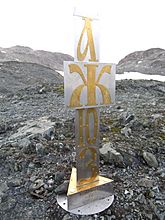
Latin Script Use
Many languages that use Cyrillic have also been written with the Latin alphabet. Examples include Azerbaijani, Uzbek, Serbian, and Romanian. After the Soviet Union broke up in 1991, some countries switched from Cyrillic to Latin. Moldova (except for Transnistria), Turkmenistan, and Azerbaijan have completed this change. Uzbekistan still uses both systems. Kazakhstan completed its official transition from Cyrillic to Latin by 2025.
The Russian government has said that Cyrillic must be used for all public communication in all parts of Russia. This helps keep the country connected. This rule was debated by speakers of many languages. For some, like Chechen and Ingush speakers, it had political meaning. For example, the Chechen government that wanted to be separate used a Latin script. Many Chechens still use it.
Sole official script Co-official with another script (either because the official language is biscriptal, or the state is bilingual) Being replaced with Latin, but is still in official use Legacy script for the official language, or large minority use Cyrillic is not widely used
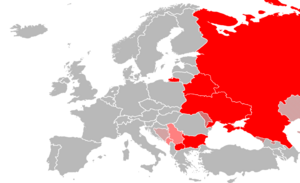
Standard Serbian uses both the Cyrillic and Latin scripts. The Serbian constitution says Cyrillic is the official script for the government. However, in everyday life, both scripts are used equally. Latin is often used more in less formal situations.
The Zhuang alphabet, used in parts of China from the 1950s to 1980s, mixed Latin, phonetic, number-based, and Cyrillic letters. In 1982, the non-Latin letters, including Cyrillic, were removed. They were replaced with Latin letters that looked similar.
Romanization: Cyrillic to Latin
Romanization is a way to write Cyrillic text using Latin letters. This can be done to show how a word is spelled or how it is pronounced.
Some common ways to romanize Cyrillic include:
- Scientific transliteration: Used in language studies, based on the Serbo-Croatian Latin alphabet.
- United Nations systems: The UN recommends different systems for specific languages. These are widely used around the world.
- ISO 9: A standard from the International Organization for Standardization.
- ALA-LC Romanization: Used in North American libraries.
Cyrillization: Other Scripts to Cyrillic
Cyrillization is the opposite process. It means writing words from other writing systems using Cyrillic letters.
Summary of Cyrillic Letters
This table shows some of the Cyrillic letters used in different languages.
| Slavic Cyrillic letters | |||||||||||
|---|---|---|---|---|---|---|---|---|---|---|---|
| А A |
А́ A with acute |
А̀ A with grave |
А̂ A with circumflex |
А̄ A with macron |
Ӑ A with breve |
Ӓ A with diaeresis |
Б Be |
В Ve |
Г Ge (Ghe) |
Ґ Ghe upturn |
Д De |
| Ђ Dje |
Ѓ Gje |
Е Ye |
Е́ Ye with acute |
Ѐ Ye with grave |
Е̂ Ye with circumflex |
Е̄ Ye with macron |
Ё Yo |
Є Ukrainian Ye |
Є́ Ukrainian Ye with acute |
Ж Zhe |
З Ze |
| З́ Zje |
Ѕ Dze |
И I |
І Dotted I |
І́ Dotted I with acute |
Ї Yi |
Ꙇ Iota |
И́ I with acute |
Ѝ I with grave |
И̂ I with circumflex |
Ӣ I with macron |
Й Short I |
| Ӥ I with diaeresis |
Ј Je |
К Ka |
Л El |
Љ Lje |
М Em |
Н En |
Њ Nje |
О O |
О́ O with acute |
О̀ O with grave |
О̂ O with circumflex |
| О̄ O with macron |
Ӧ O with diaeresis |
П Pe |
Р Er |
С Es |
С́ Sje |
Т Te |
Ћ Tje |
Ќ Kje |
У U |
У́ U with acute |
У̀ U with grave |
| У̂ U with circumflex |
Ӯ U with macron |
Ў Short U |
Ӱ U with diaeresis |
Ф Ef |
Х Kha |
Ц Tse |
Ч Che |
Џ Dzhe |
Ш Sha |
Щ Shcha |
Ꙏ Neutral Yer |
| Ъ Hard sign (Yer) |
Ъ̀ Hard sign with grave |
Ы Yery |
Ы́ Yery |
Ь Soft sign (Yeri) |
Э E |
Э́ E with acute |
Ю Yu |
Ю́ Yu with acute |
Ю̀ Yu with grave |
Я Ya |
|
| Я́ Ya with acute |
Я̀ Ya with grave |
||||||||||
| Examples of non-Slavic Cyrillic letters (see List of Cyrillic letters for more) | |||||||||||
| А̊ A with ring |
Ә Schwa |
Ӛ Schwa with diaeresis |
Ӕ Ae |
Ғ Ghayn |
Ҕ Ge with middle hook |
Ӻ Ghayn with hook |
Ӷ Ge with descender |
Ӂ Zhe with breve |
Ӝ Zhe with diaeresis |
Ҙ Dhe |
Ӡ Abkhazian Dze |
| Ҡ Bashkir Qa |
Ҟ Ka with stroke |
Ӊ En with tail |
Ң En with descender |
Ӈ En with hook |
Ҥ En-ge |
О̆ O with breve |
Ө Oe |
Ҩ O-hook |
Ҏ Er with tick |
Ҫ The |
Ҭ Te with descender |
| Ӳ U with double acute |
Ү Ue |
Ұ Kazakh Short U |
Ҳ Kha with descender |
Ӽ Kha with hook |
Ӿ Kha with stroke |
Һ Shha (He) |
Ҵ Te Tse |
Ҷ Che with descender |
Ӌ Khakassian Che |
Ҹ Che with vertical stroke |
Ҽ Abkhazian Che |
| Ҍ Semisoft sign |
Ӏ Palochka |
||||||||||
| Cyrillic letters used in the past | |||||||||||
| Ѣ Yat |
Ꙗ Iotated A |
Ѥ Iotated E |
Ѧ Small yus |
Ѫ Big yus |
Ѩ Iotated small yus |
Ѭ Iotated big yus |
Ѯ Ksi |
ѰPsi | Ꙟ Yn |
Ѳ Fita |
Ѵ Izhitsa |
| Ѷ Izhitsa okovy |
Ҁ Koppa |
ОУ Uk |
Ѡ Omega |
Ѿ Ot |
|||||||
| Early/Reference scripts | ||||||||||||||||||||||||||||||||||||||||||||||||||||||||||||||||||||||||||||||||
|---|---|---|---|---|---|---|---|---|---|---|---|---|---|---|---|---|---|---|---|---|---|---|---|---|---|---|---|---|---|---|---|---|---|---|---|---|---|---|---|---|---|---|---|---|---|---|---|---|---|---|---|---|---|---|---|---|---|---|---|---|---|---|---|---|---|---|---|---|---|---|---|---|---|---|---|---|---|---|---|---|
| Greek | Α | Β | Γ | Δ | Ε | Ζ | Η | Θ | Ι | Κ | Λ | Μ | Ν | Ξ | Ο | Π | Ϙ | Ρ | Σ | Τ | Υ | Φ | Χ | Ψ | Ω | |||||||||||||||||||||||||||||||||||||||||||||||||||||||
| Church Slavonic | А | Б | В | Г | Д | Ѕ | Е | Ж | З | И | Ѳ | І | К | Л | М | Н | Ѯ | О | П | Ҁ | Р | С | Т | У | Ф | Х | Ѱ | Ѡ | Ц | Ч | Ш | Щ | Ъ | Ы | Ѣ | Ь | Ю | Ꙗ | Ѥ | Ѧ | Ѩ | Ѫ | Ѭ | Ѵ | ||||||||||||||||||||||||||||||||||||
| Most common shared letters | ||||||||||||||||||||||||||||||||||||||||||||||||||||||||||||||||||||||||||||||||
| Common | А | Б | В | Г | Д | Е | Ж | З | И | Й | К | Л | М | Н | О | П | Р | С | Т | У | Ф | Х | Ц | Ч | Ш | Щ | Ъ | Ы | Ь | Э | Ю | Я | ||||||||||||||||||||||||||||||||||||||||||||||||
| South Slavic languages | ||||||||||||||||||||||||||||||||||||||||||||||||||||||||||||||||||||||||||||||||
| Bulgarian | А | Б | В | Г | Д | Дз | Е | Ж | З | И | Й | К | Л | М | Н | О | П | Р | С | Т | У | Ф | Х | Ц | Ч | Дж | Ш | Щ | Ъ | Ь | Ю | Я | ||||||||||||||||||||||||||||||||||||||||||||||||
| Macedonian | А | Б | В | Г | Д | Ѓ | Ѕ | Е | Ж | З | И | Ј | К | Л | Љ | М | Н | Њ | О | П | Р | С | Т | Ќ | У | Ф | Х | Ц | Ч | Џ | Ш | |||||||||||||||||||||||||||||||||||||||||||||||||
| Serbian | А | Б | В | Г | Д | Ђ | Е | Ж | З | И | Ј | К | Л | Љ | М | Н | Њ | О | П | Р | С | Т | Ћ | У | Ф | Х | Ц | Ч | Џ | Ш | ||||||||||||||||||||||||||||||||||||||||||||||||||
| Montenegrin | А | Б | В | Г | Д | Ђ | Е | Ж | З | З́ | И | Ј | К | Л | Љ | М | Н | Њ | О | П | Р | С | С́ | Т | Ћ | У | Ф | Х | Ц | Ч | Џ | Ш | ||||||||||||||||||||||||||||||||||||||||||||||||
| East Slavic languages | ||||||||||||||||||||||||||||||||||||||||||||||||||||||||||||||||||||||||||||||||
| Russian | А | Б | В | Г | Д | Е | Ё | Ж | З | И | Й | К | Л | М | Н | О | П | Р | С | Т | У | Ф | Х | Ц | Ч | Ш | Щ | Ъ | Ы | Ь | Э | Ю | Я | |||||||||||||||||||||||||||||||||||||||||||||||
| Belarusian | А | Б | В | Г | Ґ | Д | Дж | Дз | Е | Ё | Ж | З | І | Й | К | Л | М | Н | О | П | Р | С | Т | У | Ў | Ф | Х | Ц | Ч | Ш | ’ | Ы | Ь | Э | Ю | Я | ||||||||||||||||||||||||||||||||||||||||||||
| Ukrainian | А | Б | В | Г | Ґ | Д | Е | Є | Йо | Ж | З | И | І | Ї | Й | К | Л | М | Н | О | П | Р | С | Т | У | Ф | Х | Ц | Ч | Ш | Щ | ’ | Ь | Ю | Я | |||||||||||||||||||||||||||||||||||||||||||||
| Rusyn | А | Б | В | Г | Ґ | Д | Е | Є | Ё | Ж | З | И | І | Ї | Й | К | Л | М | Н | О | П | Р | С | Т | У | Ф | Х | Ц | Ч | Ш | Щ | Ъ | Ы | Ь | Э | Ю | Я | |||||||||||||||||||||||||||||||||||||||||||
| Iranian languages | ||||||||||||||||||||||||||||||||||||||||||||||||||||||||||||||||||||||||||||||||
| Kurdish | А | Б | В | Г | Г' | Д | Е | Ә | Ә' | Ж | З | И | Й | К | К' | Л | М | Н | О | Ӧ | П | П' | Р | Р' | С | Т | Т' | У | Ф | Х | Һ | Һ' | Ч | Ч' | Ш | Щ | Ь | Э | Ԛ | Ԝ | ||||||||||||||||||||||||||||||||||||||||
| Ossetian | А | Ӕ | Б | В | Г | Гъ | Д | Дж | Дз | Е | Ё | Ж | З | И | Й | К | Къ | Л | М | Н | О | П | Пъ | Р | С | Т | Тъ | У | Ф | Х | Хъ | Ц | Цъ | Ч | Чъ | Ш | Щ | Ъ | Ы | Ь | Э | Ю | Я | |||||||||||||||||||||||||||||||||||||
| Tajik | А | Б | В | Г | Ғ | Д | Е | Ё | Ж | З | И | Ӣ | Й | К | Қ | Л | М | Н | О | П | Р | С | Т | У | Ӯ | Ф | Х | Ҳ | Ч | Ҷ | Ш | Ъ | Э | Ю | Я | |||||||||||||||||||||||||||||||||||||||||||||
| Romance languages | ||||||||||||||||||||||||||||||||||||||||||||||||||||||||||||||||||||||||||||||||
| Moldovan (Romanian) |
А | Б | В | Г | Д | Е | Ж | Ӂ | З | И | Й | К | Л | М | Н | О | П | Р | С | Т | У | Ф | Х | Ц | Ч | Ш | Ы | Ь | Э | Ю | Я | |||||||||||||||||||||||||||||||||||||||||||||||||
| Uralic languages | ||||||||||||||||||||||||||||||||||||||||||||||||||||||||||||||||||||||||||||||||
| Komi-Permyak | А | Б | В | Г | Д | Е | Ё | Ж | З | И | І | Й | К | Л | М | Н | О | Ӧ | П | Р | С | Т | У | Ф | Х | Ц | Ч | Ш | Щ | Ъ | Ы | Ь | Э | Ю | Я | |||||||||||||||||||||||||||||||||||||||||||||
| Meadow Mari | А | Б | В | Г | Д | Е | Ё | Ж | З | И | Й | К | Л | М | Н | Ҥ | О | Ӧ | П | Р | С | Т | У | Ӱ | Ф | Х | Ц | Ч | Ш | Щ | Ъ | Ы | Ь | Э | Ю | Я | ||||||||||||||||||||||||||||||||||||||||||||
| Hill Mari | А | Ӓ | Б | В | Г | Д | Е | Ё | Ж | З | И | Й | К | Л | М | Н | О | Ӧ | П | Р | С | Т | У | Ӱ | Ф | Х | Ц | Ч | Ш | Щ | Ъ | Ы | Ӹ | Ь | Э | Ю | Я | |||||||||||||||||||||||||||||||||||||||||||
| Kildin Sami | А | Ӓ | Б | В | Г | Д | Е | Ё | Ж | З | И | Й | Ҋ | Ј | К | Л | Ӆ | М | Ӎ | Н | Ӊ | Ӈ | О | П | Р | Ҏ | С | Т | У | Ф | Х | Һ | Ц | Ч | Ш | Щ | Ъ | Ы | Ь | Ҍ | Э | Ӭ | Ю | Я | ||||||||||||||||||||||||||||||||||||
| Udmurt | А | Б | В | Г | Д | Е | Ё | Ж | Ӝ | З | Ӟ | И | Ӥ | Й | К | (К̈) | Л | М | Н | О | Ӧ | П | Р | С | Т | У | Ф | Х | Ц | Ч | Ӵ | Ш | Щ | Ъ | Ы | Ь | Э | Ю | Я | |||||||||||||||||||||||||||||||||||||||||
| Turkic languages | ||||||||||||||||||||||||||||||||||||||||||||||||||||||||||||||||||||||||||||||||
| Azerbaijani | А | Б | В | Г | Ғ | Д | Е | Ә | Ё | Ж | З | И | Ј | Й | К | Ҝ | Л | М | Н | О | Ө | П | Р | С | Т | У | Ү | Ф | Х | Һ | Ц | Ч | Ҹ | Ш | Щ | Ъ | Ы | Ь | Э | Ю | Я | |||||||||||||||||||||||||||||||||||||||
| Bashkir | А | Б | В | Г | Ғ | Д | Ҙ | Е | Ё | Ж | З | И | Й | К | Ҡ | Л | М | Н | Ң | О | Ө | П | Р | С | Ҫ | Т | У | Ү | Ф | Х | Һ | Ц | Ч | Ш | Щ | Ъ | Ы | Ь | Э | Ә | Ю | Я | ||||||||||||||||||||||||||||||||||||||
| Chuvash | А | Ӑ | Б | В | Г | Д | Е | Ё | Ӗ | Ж | З | И | Й | К | Л | М | Н | О | П | Р | С | Ҫ | Т | У | Ӳ | Ф | Х | Ц | Ч | Ш | Щ | Ъ | Ы | Ь | Э | Ю | Я | |||||||||||||||||||||||||||||||||||||||||||
| Kazakh | А | Ә | Б | В | Г | Ғ | Д | Е | Ё | Ж | З | И | І | Й | К | Қ | Л | М | Н | Ң | О | Ө | П | Р | С | Т | У | Ұ | Ү | Ф | Х | Һ | Ц | Ч | Ш | Щ | Ъ | Ы | Ь | Э | Ю | Я | ||||||||||||||||||||||||||||||||||||||
| Kyrgyz | А | Б | Г | Д | Е | Ё | Ж | З | И | Й | К | Л | М | Н | Ң | О | Ө | П | Р | С | Т | У | Ү | Х | Ч | Ш | Ы | Э | Ю | Я | ||||||||||||||||||||||||||||||||||||||||||||||||||
| Tatar | А | Ә | Б | В | Г | Д | Е | Ё | Ж | Җ | З | И | Й | К | Л | М | Н | Ң | О | Ө | П | Р | С | Т | У | Ү | Ф | Х | Һ | Ц | Ч | Ш | Щ | Ъ | Ы | Ь | Э | Ю | Я | |||||||||||||||||||||||||||||||||||||||||
| Uzbek | А | Б | В | Г | Ғ | Д | Е | Ё | Ж | З | И | Й | К | Қ | Л | М | Н | О | П | Р | С | Т | У | Ў | Ф | Х | Ҳ | Ч | Ш | Ъ | Э | Ю | Я | |||||||||||||||||||||||||||||||||||||||||||||||
| Mongolian languages | ||||||||||||||||||||||||||||||||||||||||||||||||||||||||||||||||||||||||||||||||
| Buryat | А | Б | В | Г | Д | Е | Ё | Ж | З | И | Й | Л | М | Н | О | Ө | П | Р | С | Т | У | Ү | Х | Һ | Ц | Ч | Ш | Ы | Ь | Э | Ю | Я | ||||||||||||||||||||||||||||||||||||||||||||||||
| Khalkha | А | Б | В | Г | Д | Е | Ё | Ж | З | И | Й | К | Л | М | Н | О | Ө | П | Р | С | Т | У | Ү | Ф | Х | Ц | Ч | Ш | Щ | Ъ | Ы | Ь | Э | Ю | Я | |||||||||||||||||||||||||||||||||||||||||||||
| Kalmyk | А | Ә | Б | В | Г | Һ | Д | Е | Ж | Җ | З | И | Й | К | Л | М | Н | Ң | О | Ө | П | Р | С | Т | У | Ү | Х | Ц | Ч | Ш | Ь | Э | Ю | Я | ||||||||||||||||||||||||||||||||||||||||||||||
| Caucasian languages | ||||||||||||||||||||||||||||||||||||||||||||||||||||||||||||||||||||||||||||||||
| Abkhaz | А | Б | В | Г | Ҕ | Д | Дә | Џ | Е | Ҽ | Ҿ | Ж | Жә | З | Ӡ | Ӡә | И | Й | К | Қ | Ҟ | Л | М | Н | О | Ҩ | П | Ҧ | Р | С | Т | Тә | Ҭ | Ҭә | У | Ф | Х | Ҳ | Ҳә | Ц | Цә | Ҵ | Ҵә | Ч | Ҷ | Ш | Шә | Щ | Ы | |||||||||||||||||||||||||||||||
| Sino-Tibetan languages | ||||||||||||||||||||||||||||||||||||||||||||||||||||||||||||||||||||||||||||||||
| Dungan | А | Б | В | Г | Д | Е | Ё | Ж | Җ | З | И | Й | К | Л | М | Н | Ң | Ә | О | П | Р | С | Т | У | Ў | Ү | Ф | Х | Ц | Ч | Ш | Щ | Ъ | Ы | Ь | Э | Ю | Я | ||||||||||||||||||||||||||||||||||||||||||
- Ё in Russian is usually spelled as Е. Ё is typically printed in texts for learners and in dictionaries. It is also used in word pairs that are only different because of that letter.
Computer Use for Cyrillic
Unicode for Cyrillic
Unicode is a system that helps computers show text from different languages. Cyrillic letters, including those from national and older alphabets, are stored in several Unicode sections.
These sections include:
- Cyrillic: U+0400–U+04FF
- Cyrillic Supplement: U+0500–U+052F
- Cyrillic Extended-A: U+2DE0–U+2DFF
- Cyrillic Extended-B: U+A640–U+A69F
- Cyrillic Extended-C: U+1C80–U+1C8F
- Cyrillic Extended-D: U+1E030–U+1E08F
Unicode usually does not include Cyrillic letters with accents. However, there are a few exceptions. These include letters that are considered separate letters in their alphabets. Some common combinations in Bulgarian and Macedonian are also included.
Other Ways to Encode Cyrillic
There are other systems for encoding Cyrillic characters for computers:
- CP866: An 8-bit system from Microsoft for MS-DOS.
- ISO/IEC 8859-5: An 8-bit system from the International Organization for Standardization.
- KOI8-R: An 8-bit Russian system. It was designed so that text would still be somewhat readable even if some computer data was lost.
- Windows-1251: An 8-bit system from Microsoft for Windows.
Keyboard Layouts
Each language that uses Cyrillic has its own standard keyboard layout. These layouts come from traditional typewriters. If a Cyrillic keyboard is not available, people sometimes use a method called "transliteration" or "volapuk encoding." This lets them type Cyrillic words using a keyboard they are more familiar with, like an English QWERTY keyboard.
See also
 In Spanish: Alfabeto cirílico para niños
In Spanish: Alfabeto cirílico para niños
- Cyrillic Alphabet Day
- Faux Cyrillic, using fake Cyrillic letters to make Latin text look Russian
- Russian Braille
- Russian cursive
Internet Top-Level Domains in Cyrillic
- gTLDs
- .мон
- .бг
- .қаз
- .рф
- .срб
- .укр
- .мкд
- .бел


